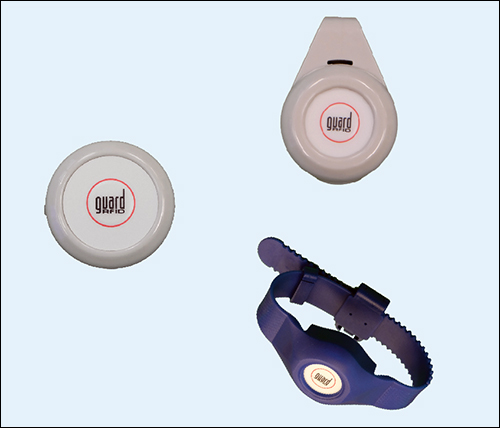Real-time location system (RTLS) technology provider GuardRFID Solutions—a Canadian Internet of Things (IoT) firm launched in 2007 that supplies data for asset management, as well as for personnel and patient tracking—has released a push-button alerting RFID tag that fits on a wristband or can serve as a small lanyard to enable a wearer to quickly summon help. The Personnel Tag (PT-3) wristband, designed for patient and employee safety, uses active RFID to transmit its unique ID number, which can be linked in software to the tag’s location. Companies in the health-care and oil and gas industries are currently testing the tag.
The Personnel Tag can be worn as a wristband or a pendant and is designed to provide companies with the location of an individual, along with an alert, when he or she presses the tag’s push button. GuardRFID demonstrated the new product at this year’s RFID Journal LIVE! conference and exhibition, held this month in Phoenix, Ariz. The company calls the PT-3 its most versatile tag to date, partly because of its size, says Marek Dutkiewicz, GuardRFID’s VP of technology and product strategy. The device is lightweight, Dutkiewicz says, and its quarter-sized face consists of a single duress button, making it easy to find and press.
Traditional duress tags can be relatively heavy and cumbersome, Dutkiewicz explains, which could inhibit a wearer’s movement. In the oil and gas sector or in other industrial settings, many personnel alerting devices are worn on lanyards, but these pose the risk of becoming caught in machinery. What’s more, workers wearing a typical man-down device on a belt can find it challenging to quickly press the right button. There is a different challenge in the health-care market, in which many of those wearing the tag might be patients, potentially elderly dementia sufferers. In their case, a cumbersome alerting device could simply be removed, leaving a patient unprotected.
The solution to both health-care and industrial use cases, the company reports, is a wristband or small pendant containing a single large button, thereby making it easy to wear and easy for a person to press in the event of an emergency. Unlike many duress tags currently on the market, Dutkiewicz explains, “The PT-3 can we worn snuggly against the wrist or attached to a belt clip or keychain using the pendant. This attaches it to the wearer in a better position than the lanyard types.”
The tags transmit data to a receiver via active 433 MHz technology using a proprietary air-interface protocol. Those deploying the solution would utilize GuardRFID’s readers to capture those transmissions. The readers could be installed around a facility or yard and can typically be plugged directly into an outlet. They will then automatically begin receiving RFID transmissions. The devices could also be solar-powered. They can use a wired Ethernet connection or Wi-Fi to send data to the cloud, or to a server on the premises. A third option is to host data on an end user’s cloud-based server using GuardRFID’s Enterprise Server software.
If an individual presses the button on his or her PT-3 device, that action prompts its built-in active RFID tag to transmit its emergency status, along with its unique ID, which the nearest readers then capture. The readers forward the collected data to GuardRFID’s cloud-based AllGuard software via a Wi-Fi connection. The software can store data such as the name, title or health status of the individual connected with that tag, and can calculate the badge’s location based on the specific reader’s signal strength and angle of arrival. When the alarm is received, the software can be configured to generate such responses as sending notifications to authorized personnel, or triggering an audible alarm.
In addition, the system could come with 125 kHz RFID tag exciters that can prompt the wristband to transmit a signal, which could be installed at a location such as the exit to a health-care facility or a secure zone at an oil and gas site. Those exciters could be configured to transmit a signal at a radius of 2 to 30 feet, according to a user’s particular needs.
The wristband is made with antibacterial thermoplastic polyurethane material to sustain repeated washing and disinfection. “We believe this is the smallest active RFID tag in the world which also includes a push button,” Dutkiewicz states.
Several companies have been testing the new wristbands, in both the health-care and oil and gas sectors, since February of this year. In the case of oil and gas, personnel working at a large or remote facility can wear the bracelet, similarly to a watch, and can simply press the button if they are hurt or require assistance. The system can also determine a person’s location in real time in the event that an evacuation is needed.
With regard to health care, those providing care to patients can wear the device on a wristband or as a pendant on a lanyard. In this scenario, their concerns center around patients in distress or threats to their own safety. As with oil and gas workers, a health-care provider could easily trigger a response from safety officers by pressing the button.
Patients, including those with dementia, can wear the device to not only provide a hospital or care facility with real-time data about their location, but also signal when they require assistance. Thus, if a patient were to go for a walk (in a facility garden, for instance) and fall or otherwise have a health-care emergency, he or she could use the PT-3 to issue an alert and indicate his or her location.
“We also expect that the tag will have use in manufacturing environments,” Dutkiewicz states. While AllGuard is “cloud-capable,” he says, most of the company’s customers deploy it on their own local server. The product is currently available and ready for order, the company reports.



